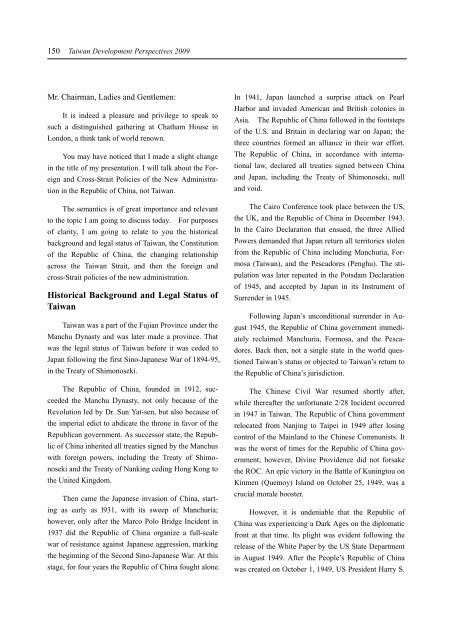PDF(2.7mb) - 國家政策研究基金會
PDF(2.7mb) - 國家政策研究基金會
PDF(2.7mb) - 國家政策研究基金會
You also want an ePaper? Increase the reach of your titles
YUMPU automatically turns print PDFs into web optimized ePapers that Google loves.
150 Taiwan Development Perspectives 2009<br />
Mr. Chairman, Ladies and Gentlemen:<br />
It is indeed a pleasure and privilege to speak to<br />
such a distinguished gathering at Chatham House in<br />
London, a think tank of world renown.<br />
You may have noticed that I made a slight change<br />
in the title of my presentation. I will talk about the Foreign<br />
and Cross-Strait Policies of the New Administration<br />
in the Republic of China, not Taiwan.<br />
The semantics is of great importance and relevant<br />
to the topic I am going to discuss today. For purposes<br />
of clarity, I am going to relate to you the historical<br />
background and legal status of Taiwan, the Constitution<br />
of the Republic of China, the changing relationship<br />
across the Taiwan Strait, and then the foreign and<br />
cross-Strait policies of the new administration.<br />
Historical Background and Legal Status of<br />
Taiwan<br />
Taiwan was a part of the Fujian Province under the<br />
Manchu Dynasty and was later made a province. That<br />
was the legal status of Taiwan before it was ceded to<br />
Japan following the first Sino-Japanese War of 1894-95,<br />
in the Treaty of Shimonoseki.<br />
The Republic of China, founded in 1912, succeeded<br />
the Manchu Dynasty, not only because of the<br />
Revolution led by Dr. Sun Yat-sen, but also because of<br />
the imperial edict to abdicate the throne in favor of the<br />
Republican government. As successor state, the Republic<br />
of China inherited all treaties signed by the Manchus<br />
with foreign powers, including the Treaty of Shimonoseki<br />
and the Treaty of Nanking ceding Hong Kong to<br />
the United Kingdom.<br />
Then came the Japanese invasion of China, starting<br />
as early as l931, with its sweep of Manchuria;<br />
however, only after the Marco Polo Bridge Incident in<br />
1937 did the Republic of China organize a full-scale<br />
war of resistance against Japanese aggression, marking<br />
the beginning of the Second Sino-Japanese War. At this<br />
stage, for four years the Republic of China fought alone.<br />
In 1941, Japan launched a surprise attack on Pearl<br />
Harbor and invaded American and British colonies in<br />
Asia. The Republic of China followed in the footsteps<br />
of the U.S. and Britain in declaring war on Japan; the<br />
three countries formed an alliance in their war effort.<br />
The Republic of China, in accordance with international<br />
law, declared all treaties signed between China<br />
and Japan, including the Treaty of Shimonoseki, null<br />
and void.<br />
The Cairo Conference took place between the US,<br />
the UK, and the Republic of China in December 1943.<br />
In the Cairo Declaration that ensued, the three Allied<br />
Powers demanded that Japan return all territories stolen<br />
from the Republic of China including Manchuria, Formosa<br />
(Taiwan), and the Pescadores (Penghu). The stipulation<br />
was later repeated in the Potsdam Declaration<br />
of 1945, and accepted by Japan in its Instrument of<br />
Surrender in 1945.<br />
Following Japan’s unconditional surrender in August<br />
1945, the Republic of China government immediately<br />
reclaimed Manchuria, Formosa, and the Pescadores.<br />
Back then, not a single state in the world questioned<br />
Taiwan’s status or objected to Taiwan’s return to<br />
the Republic of China’s jurisdiction.<br />
The Chinese Civil War resumed shortly after,<br />
while thereafter the unfortunate 2/28 Incident occurred<br />
in 1947 in Taiwan. The Republic of China government<br />
relocated from Nanjing to Taipei in 1949 after losing<br />
control of the Mainland to the Chinese Communists. It<br />
was the worst of times for the Republic of China government;<br />
however, Divine Providence did not forsake<br />
the ROC. An epic victory in the Battle of Kuningtou on<br />
Kinmen (Quemoy) Island on October 25, 1949, was a<br />
crucial morale booster.<br />
However, it is undeniable that the Republic of<br />
China was experiencing a Dark Ages on the diplomatic<br />
front at that time. Its plight was evident following the<br />
release of the White Paper by the US State Department<br />
in August 1949. After the People’s Republic of China<br />
was created on October 1, 1949, US President Harry S.

















